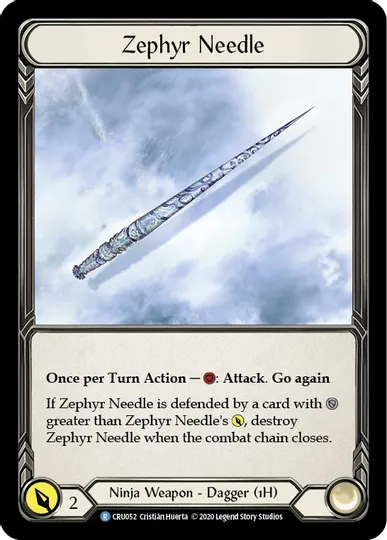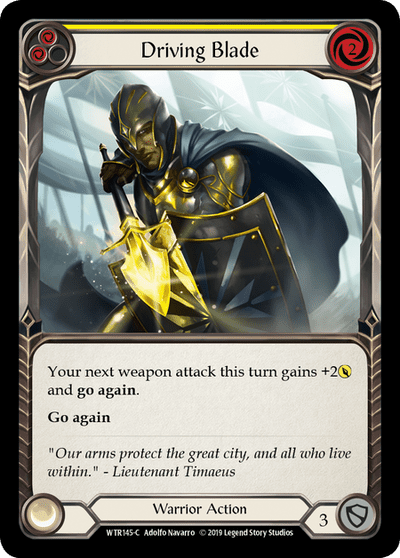It’s not often that we see new competitive trading card games arise to the same level as the Big Three (Magic, Pokemon, and YuGiOh). However, a small indie studio released a new CCG that’s been catching everyone’s eyes, including several pro players across the board.
It was designed to be a one-on-one competitive game that’s played in-person, at competitive events similar to Magic: The Gathering’s former ProTour structure. The game was designed by James White, who formerly worked at Wizards of the Coast (the folks who make Magic: The Gathering). The studio spent over seven years working on this unique CCG, released in 2019.
Key Details Up Front: Flesh and Blood is a competitive trading card game from publishers Legendary Story Studios. Essentially, you play as a Hero fighting against another Hero in one-on-one combat. Each hero has their equipment like armor, weapons, and more. As you play, you’ll draw cards to attack and defend from your opponent in a unique combat system called the Attack Chain.
How To Get Flesh and Blood Cards

Thanks to the COVID-19 pandemic and the current global shipping prices, purchasing Flesh and Blood cards have been challenging over the last two years. Paired on top of insanely high prices for cards in the original print, it’s been challenging to find good information.
Flesh and Blood has a unique way of printing that other CCGs and TCG’s have never tried before. Traditionally, games like Magic and YuGiOh stop printing cards for that set a year or so after its release. This can inflate prices as there’s no longer a source of new cards entering the market.
Unlike those games, F&B chose to have continuous print runs of these sets instead. Each set has two different printings:
- The First Print of a set contains a unique foil of cards in the set that isn’t available anywhere else.
- The Unlimited Edition of a set is the second release of a set. These contain the exact same cards but don’t have the same foiling effects.
This means that card prices will always be lower, but collectors can price their First Print cards higher. Having an unlimited print run means that the barrier to entry is much lower compared to Magic and YuGiOh, where cards from older sets are often expensive and hard to find.
Is this Game A Fad?

It’s tough to say. The game reached the USA and Europe right at the start of the pandemic, and they’ve experienced several issues along the way. However, they did manage to have several successful large-scale in-person events in 2021.
The biggest issue is the amount of misinformation that currently surrounds the game. Rumors that the game is a cash grab, a Ponzi scheme, or intentional imbalanced all float around the internet.
Are they true? No. But the game is too early to tell if it will have any lasting power like its predecessors.
How to Play Flesh and Blood

Now that you’ve got your cards, let’s figure out how to play! I’ll go over the steps and show you deck construction, as well as some brief rules.
Picking a Format
Like most other CCGs, Flesh and Blood offers a few different formats. While I won’t cover all of them, I’ll mention a few popular formats:
- Classic Constructed is the “normal” way to play. Each player builds an 80 card deck with their hero and fights one-on-one with another player in a best of three.
- Blitz is faster, with half the deck size and playing as a Young Hero instead. These are meant to be shorter, best-of-one games.
- Booster Draft follows many of the same rules as drafting in other games. You pick single cards from booster packs as you pass them around the table with seven different players and create a deck from what you’ve selected.
- Sealed Deck runs like Sealed events in other CCGs, where you open several booster packs and create a deck out of those cards.
Be sure to check with your local game store to see what formats they support.
Picking a Hero
Heroes make up the key point of the game. Each player picks a hero that determines what cards they can play and how their deck’s playstyle is. Most Heroes have an Old and a Young version. Young heroes are only for Blitz decks and cannot be played in other formats, so be careful.
All heroes have an intellect, which determines how many cards you draw at the start of the game. You will also draw up to that same number of cards at the end of your turn.
Additionally, each hero has a class as well. Your hero’s class determines what cards you can have in your deck. As of right now, there are many classes to choose from, and new sets have a chance to add more to the game.
Here’s a brief list of what’s available:
- Brute
- Elemental
- Guardian
- Illusionist
- Light
- Mechanologist
- Merchant
- Ninja
- Ranger
- Runeblade
- Shadow
- Shapeshifter
- Warrior
- Wizard
Weapons and Equipment

Once you’ve picked out a hero, it’s time to kit them out! Heroes can equip one or two weapons and equipment for their head, chest, arms, and legs. You start the game with your hero fully equipped with weapons and equipment.
Weapons will generally have effects that will trigger when you’re attacking or defending. They can be one or two-handed, with two-handed weapons meaning they take up both weapon slots.
Equipment is what your hero’s wearing. They have their defense values and can be destroyed if they take too much damage.
Using an Action
You start with one Action Point each turn, which you can spend to use your weapon, Hero Ability, or an Action card from your hand. Each card will have a cost to use, and when you play that card or use that action, you spend those resources. We’ll cover how that works in the next section, so don’t worry.
Some cards have the words “Go again”, which translates to “gain one Action Point”. This means that you can chain actions together, provided you draw the right cards and have enough resources.
Gaining and Using Resources
To use any Action Points, you’ll need to pay for them first. Actions can cost 1-3 resources, which you gain by pitching cards.

The number in the top right of the card shows how many resources it costs to use this spell. The number of red pips in the top left determines how many resources you gain from pitching this card from your hand.
You can also use the colored strip at the top to figure out how many resources you gain from pitching it. Red is one, yellow is two, and blue is three resources.
To use a card, you’ll need to declare it. Once you do, you’ll need to pitch cards from your hand to generate enough resources to pay for it. You cannot pitch cards whenever you want, but you can pitch for more than you need for that card.
Resources only last until the end of your turn, so make sure not to spend more than you need!
Card Types
Your deck will have several cards with different types that each does different things.
- Action cards are usually attacks or tactical moves.
- Attack / Defense Reactions are all the tricks and tools during combat. You’ll use attack reactions to beef up your strikes and defense reactions to protect yourself.
- Instants can be used during anyone’s turns.
The Attack Chain
This is where Flesh and Blood truly shines: The combat.
Once you’ve made an attack action, you and your opponent will take turns playing cards and reaction. This builds the “attack chain,” similar to the stack in Magic: The Gathering. During the attack chain, there are five steps that you have to follow before the chain ends:
- Attack Step: The attacker puts the card they’re attacking within the attack chain. This attack has a value (n) they’re going to deal damage with, usually in the bottom left.
- Defend Step: The defender can use their equipment or cards in their hand to prevent the damage. These cards will have defense values in grey on the bottom right of the card (x).
- Reaction Step: In this step, each player will take turns playing reaction cards from their hands. This is where the game becomes almost like Magic: The Gathering, and things get complex.
- Damage Calculation: Once both players have finished playing reactions, you’ll calculate the total damage being dealt. You take the number from the attack (n) and subtract what’s being defended (x), and whatever is left over is the damage dealt.
- Chain Link Resolution: Once this has all been done, the cards that were used all go to the graveyard unless they’re equipment and weapons. Then, you can start another combat chain if you’d like.
The Arsenal
Once your turn is over, you’ll get the chance to add to your arsenal. The arsenal is a spot below your hero where you can put one face-down card to be used later. It can’t be used to defend or pitched, but it can be used for a future turn.
Can You Play Flesh and Blood Online?
One of the reasons Flesh and Blood were created was because the designer saw most card games shifting to digital. It’s even named Flesh and Blood because you’re intended to play it in person. However, there’s no way they could have predicted the ongoing pandemic.
Sadly, there are no current plans for an official digital implementation for Flesh and Blood. However, that doesn’t mean you can’t do it!
Untap.in

A popular tool for Magic: The Gathering players began supporting F&B in 2020. It’s not an automated client, and you’ll have to learn how the client works to get started, but it’s a pretty great app.
Tabletop Simulator
Everyone’s favorite janky program, TTS, happens to offer two different mods for Flesh and Blood. There’s an OSC and a TCG mod, each with caveats and features. TTS regularly goes on sale for around $10, so if you don’t already own it, you should pick it up.
Webcam Play
The most basic way to play, all you need to do is to strap a webcam to amount above your desk/table and find some friends. Whether you play through Discord or other tools is up to you, but this is the “preferred” way to play online.
Flesh and Blood or Magic: The Gathering: Is it Worth It?

For me, I’m always going to pick Magic. It’s a game I’ve played for over ten years, and all my friends play. I’ve also already spent way too much on cards.
Magic scratches my itch for combo-centric, competitive play. But, it’s expensive and has plenty of its issues. If you don’t have a thriving Magic community near you, I’d suggest F&B.
However, I do like Flesh and Blood. I think the game is interesting, and I’m curious to see how it grows. While the game may still be new, there’s plenty of room for it to grow in the next year or two. And if the turnout for their recent Calling events says anything, it’s that this game is growing.
Frequently Asked Questions
Question: Are Flesh and Blood Expensive?
Answer: Yes, and no. There are plenty of expensive cards in the first print run of an F&B set, but that doesn’t mean they are all expensive. You can easily pick up the Unlimited versions of these cards for a fraction of the price and start playing ASAP.
Question: Can I Play Flesh and Blood Online?
Answer: As of right now, there are no plans for a digital implementation for the game. You can easily get a webcam or use Tabletop Simulator to play online, though!
Question: Are Flesh and Blood a Dying Game?
Answer: It’s still too early to tell, but it looks like Flesh and Blood is still growing. They had a great turnout for their Calling events in late 2021, and hopefully, the trend continues into 2022.
- Friends Monopoly Guide - March 6, 2023
- Men in Tanks – Lazarus’ War Guide - April 14, 2022
- Flesh and Blood Card Game Guide - March 31, 2022

